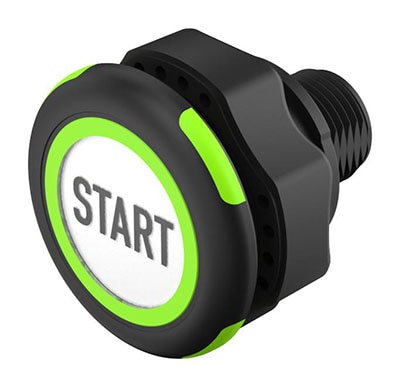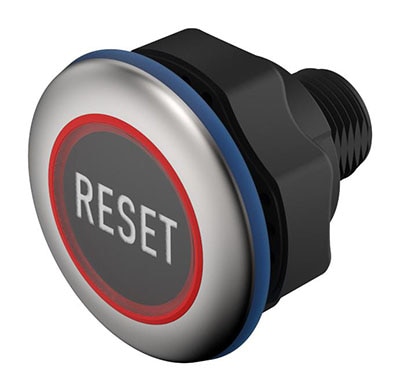An overview of best practices and tips when designing a Human-Machine Interface
How do you talk to machines?
Human Machine Interfaces, commonly known as HMIs, are deployed so that humans have an interface for control and visualization of a machine, application, or process. Although most devices have some type of HMI, this article will focus on industrial HMIs, as used in manufacturing, aerospace, transportation, and healthcare. As control systems within manufacturing are migrated from traditional push button designs to more modern displays, HMI design has become essential to any new installation. A well-designed HMI should do more than control the process; it should be safe, reliable, intuitive, and cost-effective, and provide a line of sight into the system to control or maintain the machine. This article will guide you through the best practices for designing a Human Machine Interface.
Components of an HMI
Figure 1: Control panel with short travel keys
Source: EAO
An HMI includes the following electronic components for signaling and controlling equipment and systems:
- Switches make or break an electrical connection or divert current from one conductor to another through the motion of an actuating mechanism. Switches are available in many designs, including pushbutton, rocker, slide, keylock, and rotary.
- Short travel technologies are used in industries where ease of cleaning is required. Short travel technologies include conductive rubber keys in a typical keyboard, dome keys under an overlay, or a multi-layer membrane. They are resistant to moisture and debris and provide light tactile feedback, water and dust resistance properties, and improved ergonomics.
- Touchscreen technologies are displays that have touch control capabilities. There are various types of touchscreens available, including capacitive, resistive, and infrared.
- Surface acoustic wave (SAW) touch technology uses sound waves to detect touch. High-frequency sound waves are projected across the horizontal and vertical axes. When a finger touches the surface, the corresponding sensor detects the interruption and determines the location of the touch.
- Motion control interfaces often use joystick technology to control devices requiring macro control. Examples include controlling the bucket on a payloader, robotic arm, or directional control for materials handling equipment or pull mechanisms. Motion control applications usually work with proportional output, where the joystick is interfaced with a sensor or array of sensors for directional control.
Designing an HMI
A highly reliable HMI system with safe, cost-effective, consistent, and intuitive performance relies on best engineering practices throughout the design, panel layout, production, testing, and quality assurance processes. Some important requirements and guidelines to remember when designing an HMI are as follows:
Define the functional requirements of the application
General functionality: Identify which functions need to be controlled by the interface, and determining which controls would be most suitable. This includes mechanical pushbuttons, keylocks, or rotary switches, as well as monitors and speakers to present information and feedback to operators.
Degree of input complexity: Choose the control that makes it easiest to use for the operator. The input control can be as simple as an on/off switch or as complex as a touchscreen display.
Operator feedback: Feedback is important for operator effectiveness and efficiency. Feedback can be visual, auditory, tactile, or a combination of these. Feedback is important in systems without mechanical travel, such as a touchscreen, where sounds can be used to signify a push of a button.
Environmental considerations: The HMI system must be durable enough for the environment it will be installed in. Environmental stresses include exposure to moisture, vandalism, temperature extremes, or other characteristics of harsh environments, such as an industrial production facility. For example, touchscreens are not an ideal choice in environments where oil, condensation, or airborne debris can collect on flat surfaces.
Figure 2: HMI with a variety of switches and level controls
Creating an intuitive HMI design
Designing an intuitive HMI involves considering the needs, expectations, and cognitive abilities of the users. Some best practices to follow when designing an HMI include:
User-Centered Design: Understand your target users and their goals. Conduct user research, interviews, and usability testing to gain insights into their needs, preferences, and pain points. Incorporate this understanding into the design process.
Consistency and Familiarity: Use consistent visual elements, icons, terminology, and interaction patterns throughout the interface. Align your design with widely accepted conventions to make it familiar and reduce cognitive load.
Clear and Concise Language: Use simple, jargon-free language that is easy to understand. Avoid ambiguous terms and provide clear instructions or feedback to guide users.
Visual Hierarchy: Employ a clear visual hierarchy to prioritize important information and actions. Use appropriate font sizes, colors, contrast, and spacing to direct attention and make key elements stand out.
Feedback and Response: Provide immediate and appropriate feedback to user actions. Use visual cues, animations, or audio signals to acknowledge input, confirm actions, and indicate system status or errors.
Minimalism and Simplicity: Keep the interface uncluttered and focus on essential information and controls. Avoid overwhelming users with too many options or excessive visual elements.
Progressive Disclosure: Present information and controls in a progressive manner. Initially, show only the necessary elements and provide additional options or details on-demand. This approach reduces cognitive overload and helps users focus on relevant tasks.
Error Prevention and Handling: Design the interface to prevent errors whenever possible. Use validation techniques, confirmations, and constraints to guide users towards correct actions. When errors occur, provide clear and helpful error messages that assist users in resolving the issue.
Accessibility Considerations: Ensure your HMI is accessible to users with disabilities. Follow accessibility guidelines to support features such as keyboard navigation, screen readers, color contrast, and alternative text for visual elements.
Iterative Testing and Improvement: Continuously test and evaluate your interface design with real users. Collect feedback, identify areas of confusion or difficulty, and refine the interface iteratively based on the insights gained.
Designing an intuitive HMI requires an iterative process that involves understanding your users, prototyping, testing, and refining the design based on user feedback.
Figure 3: HMI panel with joystick control and short travel keys
Switches
Shop our wide variety of HMI Switches and Components from EAO.
Don't forget to join our discussion.
Applying Human Psychology to HMI design
Understanding human psychology can help create interfaces that are more user-friendly, engaging, and effective. These are some key considerations:
Mental Models: Users often rely on mental models, which are their internal representations of how things work. Design interfaces that align with users' mental models to reduce cognitive load and enhance usability. Use familiar metaphors, icons, and interactions that match users' expectations based on their prior experiences.
Perception and Attention: Understand how users perceive and process information. Consider principles of visual perception, such as Gestalt principles (e.g., proximity, similarity, closure) to group related elements together and make visual patterns more recognizable. Use visual cues, such as color, contrast, and motion, to guide attention and highlight important information.
Hick's Law: Hick's Law states that the time it takes for a person to make a decision increases with the number of choices available. Reduce decision-making complexity by minimizing the number of options presented at once and providing clear pathways for users to achieve their goals.
Fitts's Law: Fitts's Law states that the time required to move to a target depends on the distance to the target and the size of the target. Consider this law when designing interactive elements and ensure that buttons, links, or controls are appropriately sized and placed for ease of selection.
Cognitive Load: Cognitive load refers to the mental effort required to perform a task. Reduce cognitive load by simplifying complex tasks, breaking them down into smaller steps, and providing clear instructions and feedback. Avoid overwhelming users with too much information or too many options at once.
Persuasive Design: Incorporate principles of persuasive design to influence users' behavior and encourage desired actions. Use techniques such as social proof, scarcity, authority, and feedback to motivate users and guide their decision-making process.
Emotional Design: Emotions play a significant role in user experience. Consider how the design elements, including colors, typography, and visuals, can evoke specific emotions. Understand the emotional context of the user and design interfaces that create positive emotional experiences.
Error Handling: Understand how users perceive and react to errors. Design error messages that are clear, concise, and provide guidance on how to resolve the issue. Use error prevention techniques, such as validation and constraints, to minimize errors and frustration.
These considerations highlight the importance of understanding human behavior, cognition, and emotions when designing HMIs. Incorporating psychological principles into the design process can significantly improve user satisfaction, engagement, and overall usability of the interface.
EAO Series 84 IO-Link Touch Capacitive Switches
The EAO IO-Link Series 84 Touch Switches are designed for a wide variety of industrial and commercial applications. One of the key features of the EAO IO-Link Series 84 Touch switches is their compatibility with IO-Link. IO-Link is an open standard point-to-point serial communications protocol for connecting sensors and actuators to controllers. EAO IO-Link Series 84 Touch switches are Industry 4.0-compatible and provide enhanced data exchange with advanced machines using an integrated M12 5-pin screw connection. They are compact switches with a low space requirement of 25.8 mm installation depth.

EAO IO-Link Series 84 “Standard" touch switch
Buy now
IO-Link Series 84 Touch switches are attractively designed with high contrast and optionally illuminated standard or custom symbols and can be integrated visually in any modern application setting. The switches also feature a modular design, allowing easy customization and configuration. IO-Link Touch is designed to withstand up to 100 million switching cycles, hard impact (IK08), and frontal impact (IP69K) in operating temperatures ranging from –30° to +65° Celsius.

EAO IO-Link Series 84 “Hygiene” touch switch
Buy now
Summing up: Designing a Human-Machine Interface
in partnership with

The effectiveness of the HMI System and, as a result, enhanced user productivity, depends upon an exacting design process that incorporates all technical, ergonomic, and communication requirements. The IO-Link Series 84 Touch Switches from EAO are a versatile and durable option for use in various industrial and commercial applications. Their compatibility with IO-Link technology makes them an attractive option for use in integrated automation systems.
What types of technologies will HMIs incorporate in the next 20 years? Examples might include VR, gesture sensors, and AI.
Please tell us in the Comments section below.
